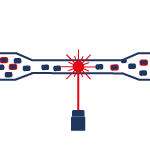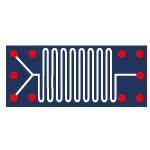Technology
rqmicro revolutionizes microbiological testing by combining immunomagnetic separation and
flow cytometry on a microfluidic cartridge system.

Immunomagnetic Separation
Enables specific isolation of target cells for downstream analysis

Flow Cytometric Detection
Rapid analysis of single cells with viability detection (live/dead)
Single-Cell Analysis of Specific Bacteria in Water

Immunomagnetic Separation
rqmicro instruments isolate target cells via magnetic particles that are coupled to specific antibodies.
In contrast to conventional IMS methods, our automated approach separates target cells during a contact-free, gentle process on a single-use microfluidic cartridge.

Cartridge System
rqmicro uses the great potential of microfluidics to deliver a product that allows for highly efficient separation and purification of target cells from samples with varying complexity.
As the sample passes through a narrow channel in the microfluidic cartridge, target cells are isolated and resuspended in a clean buffer solution.
This positive fraction can be analyzed by flow cytometry or any method of analysis by your choice.

Flow Cytometric Detection
rqmicro test kits are designed to enable the detection of specific pathogens using flow cytometry. Since it is a cultivation-independent method, all fluorescence labelled cells present in a sample, also viable but non-culturable (VBNC) cells, are quantified by FCM in a matter of minutes.
Flow cytometry is a laser-based technology for electronic cell counting that allows multiparametric analysis of the properties of thousands of cells per second. The cells labelled with a fluorescent dye pass in front of a laser in a stream of fluid. The laser excites electrons in the fluorescent dye that then return in fractions of a second to their previous state by emitting light.
The FCM detects this light signal, which is then transformed into data that is further processed within the instrument.
